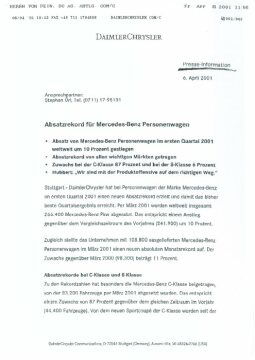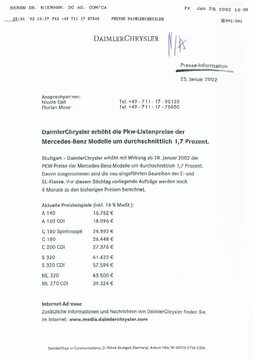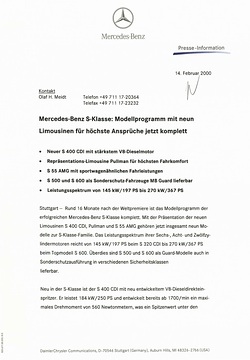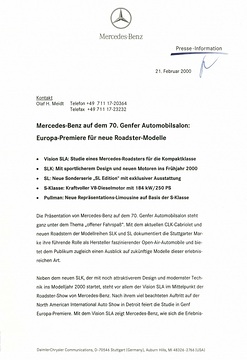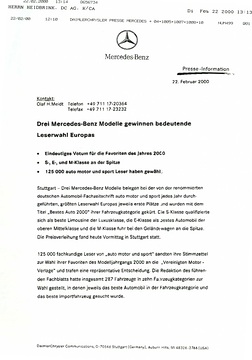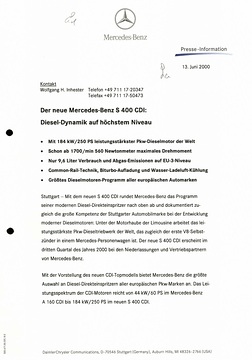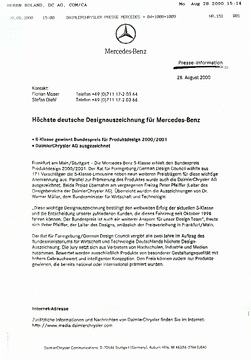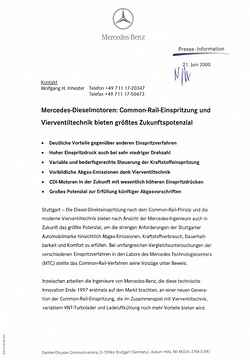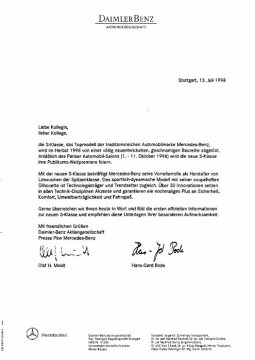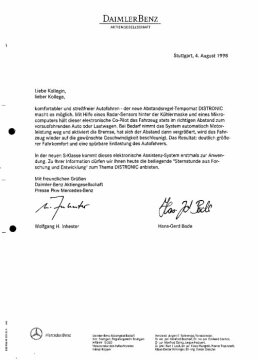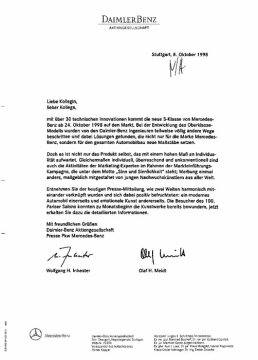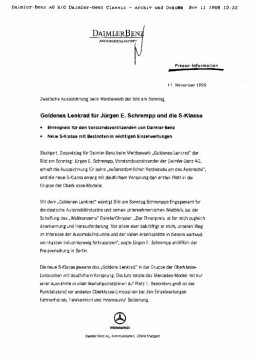Delete
Do you really want to delete the data record?
Download
Please wait a moment ...
Download
Please wait a moment ...
Download
Please wait a moment ...
Crop for shopping cart
Please wait a moment ...
Set as main picture
Do you want to set this media object as main picture?
-
Caption
:
Mercedes-Benz auf der Automobil International: Premiere für die neue C-Klasse: C-Klasse: Dynamik, Eleganz und Hightech vom Feinsten; SLK: Mit sportlicherem Design und neuen Motoren ins Frühjahr 2000; A-Klasse: Attraktiver Sondermodell „CLASSIC Fun“; SL: Neue Sonderserie „SL Edition“ mit exklusiver Ausstattung; S-Klasse: Kraftvoller V8-Dieselmotor mit 184 kW/250 PS Fotonummer: A2000F2992 Mercedes-Benz auf der AMI 2000 in Leipzig Nach über vierjähriger Entwicklungszeit geht die Limousine im Mai dieses Jahres bei den Niederlassungen und Vertriebspartnern der Stuttgarter Automobilmarke an den Start. Bereits das attraktive Design mit dem modern interpretierten Vier-Augen-Gesicht spiegelt zwei der wichtigsten Merkmale der neuen C-Klasse auf den ersten Blick wider: Dynamik und Eleganz. Die Limousine ist ein junges, progressives Automobil, das sich mit neu entwickelter Fahrwerkstechnik, leistungsstärkeren Motoren und neuesten technischen Innovationen besonders durch seine sportliche Agilitä
-
Pages
:
6
-
Caption
:
64 an einem Ring: DaimlerChrysler stellte erste Mercedes-Benz S-Klasse mit optischem Hochleistungs-Datenbus vor; Multimedia-Vernetzung mit hoher Leistungsfähigkeit und geringen Kosten; Elektronik für mehr Komfort und Sicherheit Fotonummer: keine Eine so genannte Polymer Optische Faser verbindet die Multimedia-Einrichtungen Im Auto zu einem leistungsfähigen Netz. DaimlerChrysler stellt auf dem 7. Internationalen Weltkongress für Intelligente Transportsysteme in Turin die erste Mercedes-Benz S-Klasse mit diesem optischen Datenbus vor.
-
Pages
:
3
-
Caption
:
Absatzrekord für Mercedes-Benz Personenwagen: Absatz von Mercedes-Benz Personenwagen im ersten Quartal 2001 weltweit um 10 Prozent gestiegen; Absatzrekord von allen wichtigen Märkten getragen; Zuwachs bei der C-Klasse 87 Prozent und bei der S-Klasse 6 Prozent; Hubbert: „Wir sind mit der Produktoffensive auf dem richtigen Weg.“
-
Pages
:
3
-
Caption
:
Mercedes-Benz S-Klasse: Modellprogramm mit neun Limousinen für höchste Ansprüche jetzt komplett: Neuer S 400 CDI mit stärkstem V8-Dieselmotor; Repräsentations-Limousine Pullman für höchsten Fahrkomfort; S 55 AMG mit sportwagenähnlichen Fahrleistungen; S 500 und S 600 als Sonderschutz-Fahrzeuge MB Guard lieferbar; Leistungsspektrum von 145 kW/197 PS bis 270 kW/367 PS
-
Pages
:
7
-
Caption
:
Mercedes-Benz auf dem 70. Genfer Automobilsalon: Europa-Premiere für neue Roadster-Modelle: Vision SLA: Studie eines Mercedes-Roadsters für die Kompaktklasse; SLK: Mit sportlicherem Design und neuen Motoren ins Frühjahr 2000; SL: Neue Sonderserie „SL Edition“ mit exklusiver Ausstattung; S-Klasse: Kraftvoller V8-Dieselmotor mit 184 kW/250 PS; Pullman: Neue Repräsentations-Limousine auf Basis der S-Klasse
-
Pages
:
8
-
Caption
:
Mercedes-Benz auf der Automobil International: Premiere für die neue C-Klasse: C-Klasse: Dynamik, Eleganz und Hightech vom feinsten; SLK: Mit sportlicherem Design und neuen Motoren ins Frühjahr 2000; A-Klasse: Attraktives Sondermodell „CLASSIC Fun"; SL: Neue Sonderserie „SL Edition" mit exklusiver Ausstattung; S-Klasse: Kraftvoller VS-Dieselmotor mit 184 kW /250 PS
-
Pages
:
6
-
Caption
:
Der neue Mercedes-Benz S 400 CDI: Diesel-Dynamik auf höchstem Niveau: Mit 184 kW/250 PS leistungsstärkster Pkw-Dieselmotor der Welt; Schon am 1700/min 560 Newtonmeter maximales Drehmoment; Nur 9,6 Liter Verbrauch und Abgas-Emissionen auf EU-3-Niveau; Common-Rail-Technik, Biturbo-Aufladung und Waser-Ladeluft-Kühlung; Größtes Dieselmotoren-Programm aller europäischen Automarken
-
Pages
:
7
-
Caption
:
Mercedes-Benz Dieselmotoren: Common-Rail-Einspritzung und Vierventiltechnik bieten größtes Zukunftspotenzial: Deutliche Vorteile gegenüber anderen Einspritzverfahren; Hoher Einspritzdruck auch bei sehr niedriger Drehzahl; Variable und bedarfsgerechte Steuerung der Kraftstoffeinspritzung; Vorbildliche Abgas-Emissionen dank Vierventiltechnik; CDI-Motoren in der Zukunft mit wesentlich höheren Einspritzdrücken; Großes Potenzial zur Erfüllung künftiger Abgasvorschriften
-
Pages
:
6
-
Caption
:
Ab Herbst auf dem Markt: Die neue Mercedes-Benz S-Klasse. Spitzenleistung in Technik, Komfort und Design: Technologieträger und Trendsetter. Über 30 technische Innovationen für mehr Sicherheit und Komfort; Sportlich-elegantes Design; Benzinverbrauch um 13 bis 17 Prozent gesenkt; Mehr Fahrkomfort und mehr aktiver Fahrspaß
-
Pages
:
9
-
Caption
:
„S-Klasse ist der Höhepunkt unserer Produktoffensive“: Daimler-Benz feiert Weltpremiere des neuen Spitzenmodells; Jürgen E. Schrempp: S-Klasse ist Herzstück der Marke Mercedes-Benz; Jürgen Hubbert: Neue Standards für Technik, Sicherheit und Design; Pkw-Umsatz bis Ende Juli plus 23 %, Absatz plus 28 %.
-
Pages
:
3
-
Caption
:
Pressemappe. Mercedes-Benz – Genf 2000. Mercedes-Benz auf dem 70. Genfer Automobilsalon: Mercedes-Benz in Genf: Europa-Premiere für neue Roadster-Modelle; Vision SLA: Roadster-Studie auf Basis der Mercedes-Benz A-Klasse; SLK: Erfolgreichster Roadster aktualisiert und verbessert; SL: Exklusives Sondermodell „Edition SL“ in limitierter Auflage; Roadster und Cabriolets: Weltweit umfangreiches Premium-Angebot; S-Klasse: Kraftvoller V8-Dieselmotor und luxuriöse Pullman-Limousine neu im Programm; G-Klasse: In der Schweiz erstmals mit Stern; Modellprogramm: Individualität, Dynamik, Exklusivität, Innovationen und vorbildliche Qualität; Mercedes-AMG und designo: Exklusivität auf Rädern; Motorsport: Herausforderung hoch drei; Mercedes-Benz 2000: Erfolgreichster Premiumhersteller der Welt
-
Pages
:
98
-
Caption
:
Experten loben Zuverlässigkeit und Design. Internationale Auszeichnungen für Mercedes-Personenwagen: S-Klasse in der ADAC-Pannenstatistik auf Spitzenplatz Jetzt bei den Mercedes-Niederlassungen und -Vertriebspartnem erhältlich. „Rucky": Schulranzen und Kindersitz in einem: Praktisches Zubehör für Kinder von vier bis zwölf Jahren
-
Pages
:
7
-
Caption
:
Sternstunden aus Forschung und Entwicklung. Die neue Mercedes-Benz S-Klasse: Automatische Abstandregelung per DISTRONIC: Weltpremiere für neuartiges Assistenz-System; Radar-Sensor hinter der Kühlermaske; Übersichtliche Display-Anzeige im Cockpit; Deutlicher Komfortvorteil auf stark befahrenen Strecken
-
Pages
:
13
-
Caption
:
Verkaufsstart für das neue Flaggschiff von Mercedes-Benz. Vorstellung der neuen S-Klasse: Live-Übertragung im Internet: Stuttgart. Der Vorstand der Daimler-Benz AG präsentiert am 7. September 1958 in Stuttgart die neue Mercedes-Benz S-Klasse vor internationaler Presse. Die Veranstaltung wird von 11.00 bis 12.30 Uhr [CET) live im Internet übertragen.
-
Pages
:
1
-
Caption
:
DaimlerChrysler: Jeden Tag 68 Mio. DM für Zukunfts-Investitionen; Innovationspreis für Abstandsregeltempomat der S-Klasse; Vöhringer: „Leistungsanreize sind Elemente unserer Unternehmenskultur“ Fotonummer: keine „Daimler-Benz-Innovationspreis 1998" Mit dem „Daimler-Benz-Innovationspreis 1998" wurde am 2. Dezember 1998 das Team ausgezeichnet, das den Abstandsregel-Tempomaten „Distronic" bis zur Serienreife entwickelt hat. Das System ermöglicht erstmals, den Fahrer bei der Einhaltung eines gewünschten Abstandes im Kolonnenverkehr zu unterstützen. Von links nach rechts: Flacke, Nöcker, Lauer, Dr. Desens, Dr. Achenbach, Danner, Adomat
-
Pages
:
2
-
Caption
:
Mercedes-Benz setzt erfolgreiche Preis-Wert-Strategie fort: S-Klasse: Mit Sechszylinder-CDI-Motor ab 104 052 Mark; CL: Top-Coupé mit besonders exklusiver Ausstattung; M-Klasse: Neue Dieselvariante ML 270 CDI für 69 948 Mark; CLK: Preisvorteil von rund 2500 Mark; Modelljahr 2000: Umfangreiche Aufwertung der Ausstattung; Aktive Sicherheit: ESP jetzt auch bei allen C-Klasse- und SL-Modellen serienmäßig
-
Pages
:
3
-
Caption
:
DaimlerChrysler Classic Telegramm August 1999: Rendevouz von Chrysler-Generation; 80 Jahre Gruppenarbeit; Lebendige Luft- und Raumfahrt-Tradition; Vierventiltechnik zu Ehren seiner Hoheit; Quantensprung der Unfallsicherheit; Ungleiche Brüder; Der „600er“ gab dem Fahrkomfort eine neue Dimension; Gipfeltreffen legendärer Automobil-Juwelen
-
Pages
:
3

Loading





